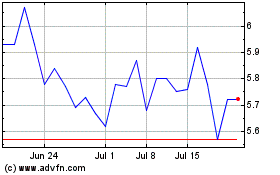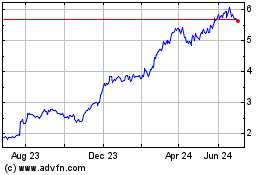Rolls-Royce Shares Soar After It Sticks to 2020 Earnings Target -- Second Update
March 07 2018 - 6:36AM
Dow Jones News
By Robert Wall
LONDON--Rolls-Royce Holdings (RR.LN) shares surged Wednesday
after the British blue-chip stuck to a closely watched 2020
earnings target despite problems with two of its highest-profile
plane engines powering Boeing Co. (BA) and Airbus SE (AIR.FR)
airliners.
Demand for commercial airplanes has been booming as more
passengers take to the sky, packing planes and helping airlines
deliver record profits. That has spurred orders for new planes and
boosted stocks in plane makers Airbus and Boeing to record
highs.
Rolls-Royce is the latest aerospace giant to benefit from the
optimism about long-term demand for more fuel-efficient planes,
even as the company struggles with component flaws on engines
powering some Boeing 787 Dreamliners and Airbus A380 superjumbos.
The blades are breaking more quickly than expected, forcing the
company to repair them more frequently than expected, and resulting
in airline operators idling planes.
"This is causing significant disruption to some of our customers
and obviously we regret that disruption," Chief Executive Warren
East told reporters.
He said the company is making "good progress" on devising fixes
for the parts on the Trent 1000, used by some carriers on Boeing
787 Dreamliners, and the Trent 900 engines powering some Airbus
A380 double-deckers.
Rolls-Royce on Wednesday said the cash costs associated with the
problem will double this year compared with the 170 million pounds
($235.8 million) free cash-flow impact recorded in 2017. Despite
this, Mr. East said the company is sticking to its free cash-flow
target of delivering about GBP1 billion around 2020.
Shares in Rolls-Royce rose around 13% in mid-morning London
trading.
Rolls-Royce has made a big bet on powering long-range airplanes
after exiting the market to power more numerous single-aisle planes
six years ago. It expects to power about half the world's long-haul
planes by 2020.
Rolls-Royce, which is no longer affiliated with the luxury car
maker, reported GBP4.2 billion net profit in 2017 compared with a
GBP4 billion loss, reflecting non-cash accounting adjustments to
its currency hedges. The more closely watched underlying pretax
profit, a figure that strips out one-time items and currency
fluctuations, rose 31% to GBP1.07 billion.
Rolls-Royce said it will take until 2022 for the Trent 1000s and
Trent 900s to be fully upgraded with more durable components.
Mr. East said the company will continue restructuring plans and
will shed white-collar jobs after a previous round of cuts saw 600
managers exit the company. The company hasn't set a cost-savings
target or defined, yet, how many jobs may go, he said.
"There is more simplification we need to do to make ourselves
truly competitive and fit for the future," Mr. East said.
Rolls-Royce has been under pressure to act after activist
investor ValueAct Capital Management LP in 2015 became its largest
shareholder. Bradley Singer, a ValueAct executive, became a
Rolls-Royce non-executive board member in 2016. That appointment is
being extended three years, Rolls-Royce said.
Rolls-Royce and ValueAct also are changing their relationship,
effectively allowing the latter to alter its shareholding. The
hedge fund, which owns almost 11% of Rolls-Royce shares, previously
was limited to owning 12.5% in the company and faced restrictions
on reducing its position. Foreigners such as ValueAct can't own
more than 15% in Rolls-Royce stock.
As part of his efforts to revamp the company, Rolls-Royce in
January announced the potential sale of its commercial-marine
business, joining rival industrial giants such as General Electric
Co. (GE) in taking steps to reinvent itself. Chief Financial
Officer Stephen Daintith said an update on the marine strategic
review should come no later than mid-June.
London-based Rolls-Royce, which makes aircraft engines also in
the U.S., said it could shield itself from potential tariffs on
steel and aluminum imports in the U.S. being threatened by the
Trump Administration.
"We will be able to adjust where we produce things to make sure
we are not paying unnecessarily high prices for raw materials," Mr
East said.
Write to Robert Wall at robert.wall@wsj.com
(END) Dow Jones Newswires
March 07, 2018 06:21 ET (11:21 GMT)
Copyright (c) 2018 Dow Jones & Company, Inc.
Rolls Royce (PK) (USOTC:RYCEY)
Historical Stock Chart
From Jun 2024 to Jul 2024

Rolls Royce (PK) (USOTC:RYCEY)
Historical Stock Chart
From Jul 2023 to Jul 2024
